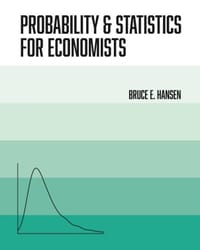Probability theory is the quantitative language used to handle uncertainty and is the foundation of modern statistics. Probability and Statistics for Economists provides graduate and PhD students with an essential introduction to mathematical probability and statistical theory, which are the basis of the methods used in econometrics. This incisive textbook teaches fundamental concepts, emphasizes modern, real-world applications, and gives students an intuitive understanding of the mathematical that every economist needs to know.
Covers probability and statistics with mathematical rigor while emphasizing intuitive explanations that are accessible to economics students of all backgrounds
Discusses random variables, parametric and multivariate distributions, sampling, the law of large numbers, central limit theory, maximum likelihood estimation, numerical optimization, hypothesis testing, and more
Features hundreds of exercises that enable students to learn by doing
Includes an in-depth appendix summarizing important mathematical results as well as a wealth of real-world examples
Can serve as a core textbook for a first-semester PhD course in econometrics and as a companion book to Bruce E. Hansen’s Econometrics
Also an invaluable reference for researchers and practitioners
Bruce E. Hansen is the Mary Claire Aschenbrener Phipps Distinguished Chair of Economics at the University of Wisconsin–Madison and one of the most highly cited econometricians in the world.

